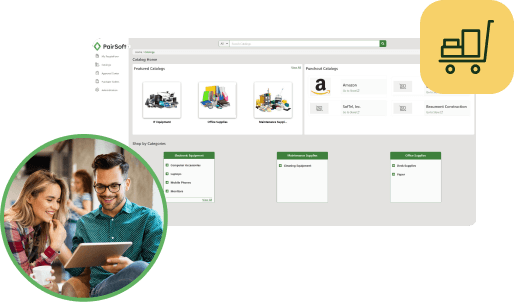The COVID-19 pandemic wreaked havoc across trade, education, government, healthcare, and more. And within almost every industry, the procurement department was left to solve unsolvable problems. Long-standing systems for balancing supply and demand fell apart, most visibly in the lack of personal protective equipment (PPE) that frontline healthcare workers needed to protect themselves and others during the crisis.
In non-healthcare fields, many workers were sent home to work, meaning that procurement (also working from home) had to quickly fill new IT and security requirements for remote employees. Budgets were exceeded, and revenue was lost as many procurement departments struggled to adapt legacy IT systems to meet new internal and external demands.
But procurement is rising to the challenge: Historically considered staid and siloed, procurement departments are embracing new ways of doing business that prioritize digital transformation, risk mitigation, and cross-collaboration.
Specifically, we’ve spotted five key procurement trends that may not be trends at all but rather new ways of doing business that will carry into 2022 and beyond. Read on for emerging trends in procurement right now, so you can evolve your department from “disrupted” to “digitally transformed.”
Embracing the Cloud
The new post-Covid environment has coincided with the availability of innovative, cloud-based apps that support functions from demand prediction and inventory optimization to supplier management and risk reduction.
Typically a pay-as-you-go service, cloud technology helps companies lower costs and scale their operations as business needs change. With a bevy of subscription-based models (SaaS, PaaS, and IaaS), organizations can scale operations with optimal solutions that yield numerous benefits:
- Companies can mix and match their own tech stacks for a more customized solution.
- There is no need for custom coding, which frees up the IR department.
- Procurement saves money by not paying for features they aren’t using.
- Business users enjoy autonomy and flexibility.
- Cloud technology enhances real-time information sharing and better decision-making.
- Imports, exports, and manual keying are a thing of the past, resulting in greater accuracy to meet regulatory compliance.
Leveraging AI and Data Analytics
Artificial intelligence (AI) is the ability of a computer-controlled system to learn and adapt its behaviors with minimal human involvement. AI is in use at almost 90 percent of companies, with procurement applications ranging from contract management and automated payments to spend analytics and supplier information management.
AI software aims to automate and streamline time-consuming tasks and deliver insights based on large, complex sets of data. In the past, it was a challenge for procurement to even determine their organization’s total spend. Today, most CPOs are deploying AI-enabled analytics to identify opportunities for bottom-line impact, ranging from process improvement to management reporting.
Going Mobile
Another emerging trend in procurement is the widespread use of mobility technology. Work-from-home had many consequences, from unplanned spending on equipment and security measures to mobile technology becoming imperative. Even as many procurement specialists return to the office, they’ll continue to rely on mobile technology—smartphones, tablets, and wearables—as they spend more time away from their desks.
The global mobile workforce is expected to reach about two billion workers (over 42 percent of the global workforce) by 2022. And the procurement world is at the ready, investing in mobile technology to support procurement and provide internal and external customers with a rich user experience. End-users can access procurement functions through a custom mobile application for Apple or Android or use the weblog into the system remotely. Have internet, will travel.
In addition to freeing stakeholders from traditional time-and-space limitations, broad mobile adoption makes the procure-to-pay (P2P) process more accessible and efficient, for everything from purchase order processing and contract management to supply chain management. And that brings us to our next significant trend in procurement.
Enabling Self-Service
One of the benefits of digital transformation is the availability of self-service, which improves the user experience for all involved. In both business and personal life, the Amazon generation wants to control their digital experiences. Speed, selection, and convenience are no longer optional, and the procurement process is no exception. From on-boarding and off-boarding to everyday vendor interaction, a self-service system is a win-win for all stakeholders and an emerging trend in procurement.
For procurement, self-service:
- avoids tedious AP tasks like invoice upload and data entry
- allows companies to get the best deals from vendors and make fast, informed decisions
- ensures compliance requirements are met—and verifiable with reporting
For vendors, self-service:
- delivers a pleasant user experience that supports long-term loyalty
- improves the bid process by eliminating phone calls, emails, and in-person presentations
Building a Resilient Supply Chain
While supply chains have been impacted in the past by acts of God and man—think the Fukushima accident in 2011 and the BP oil spill of 2010—the shock of COVID-19 will be felt for years to come. Buyers will recover (slowly) from its impact on the global economy by reinventing their supply chains to be more resilient, collaborative, and networked—even when the upfront costs are greater.
Some of the resiliency measures emerging in procurement include:
Resilience isn’t just about short-term survival; both regulatory bodies and the court of public opinion will require companies to buy from firms with wider diversity, rid their networks of any entity associated with human rights violations, and ensure sustainable procurement. This new level of accountability will require procurement specialists to know their vendors’ vendors—and their upstream value chains.
The Bottom Line
While most Chief Procurement Officers (CPOs) believe that the period of rapid response to maintain supply continuity has either passed or will end soon, 64% of CPOs are proactively evolving operations to thrive in the “new normal.” What might have been procurement “trends” in a pre-COVID world are foundational steps toward a new way of doing business that is more digital, visible, and resilient. The result is a more adaptable procurement model that leverages the best technology, from cloud computing and native mobility to social collaboration and AI-enabled decision-making.
Pairsoft brings together industry leaders PaperSave, Paramount WorkPlace, and Webiplex to deliver the most robust procure-to-pay platform for the mid-market and enterprise and direct integrations to Microsoft Dynamics, Blackbaud, NetSuite, and Sage ERPs. Ready to transform and future-proof your procurement process? Book a demo with our team.






